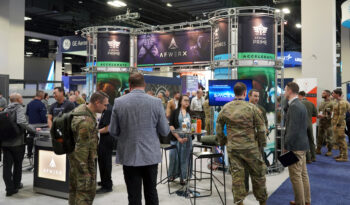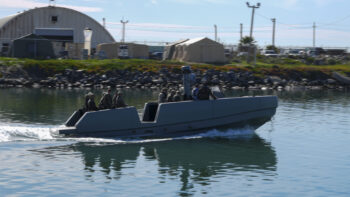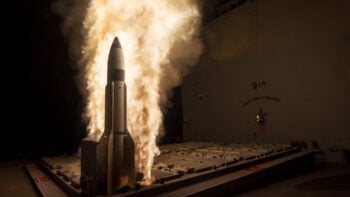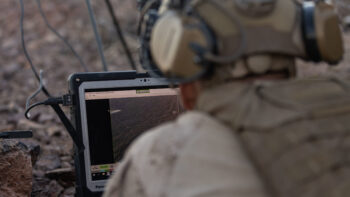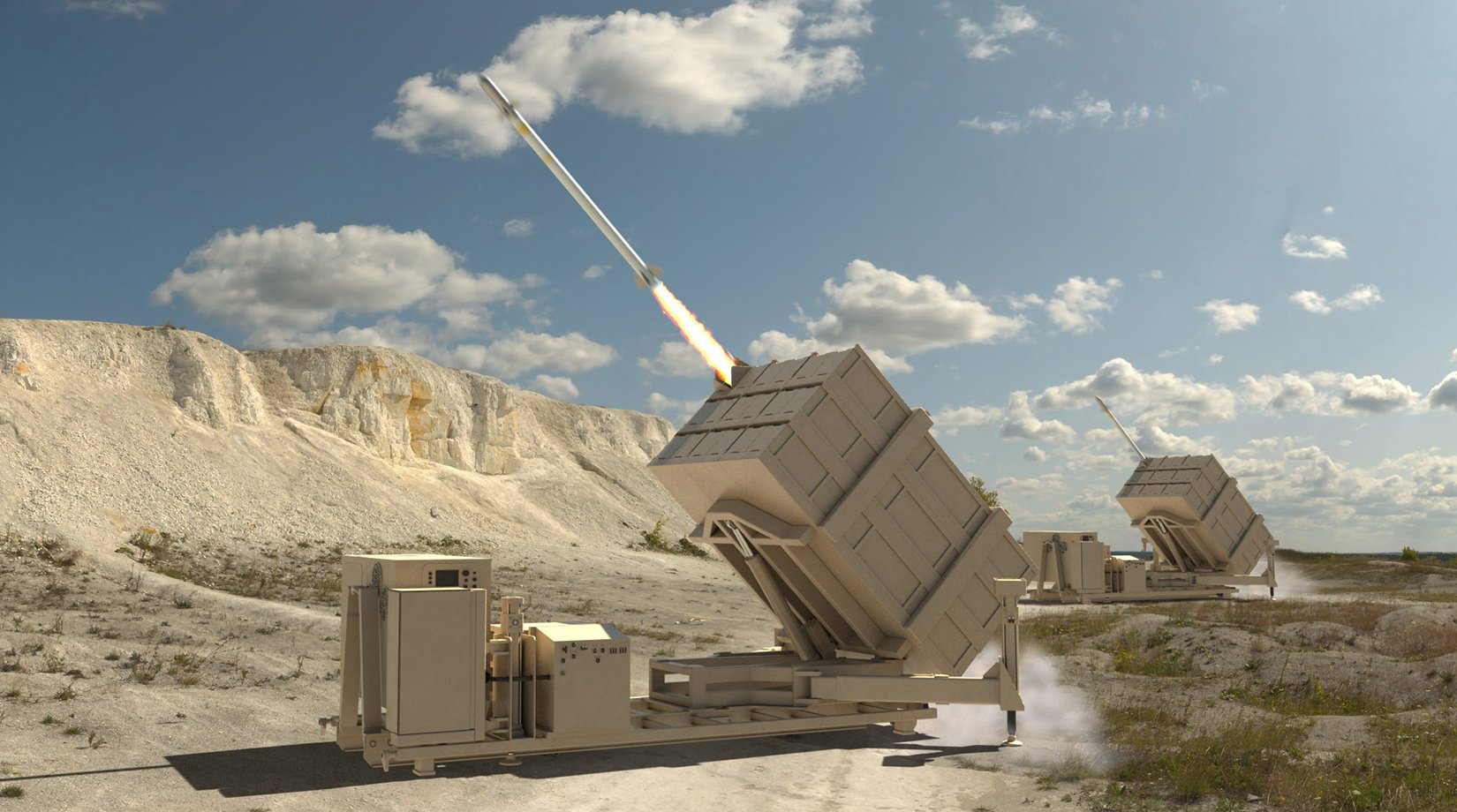
Dynetics began delivering its Enduring Shied launcher prototypes to the Army in December 2023 and has now handed over eight. (Dynetics)
UPDATED 01/29/2024 at 10:50am ET to include confirmation from Boeing that it, too, plans to bid on IFPC Inc 2.
WASHINGTON — Companies eyeing a spot on the US Army’s Indirect Fire Protection Capability Increment 2 (IFPC Inc 2) program are lining up their cruise missile interceptor candidates for a new competition for a second projectile.
The service published the official request for information on Thursday for a second IFPC Inc. 2 interceptor aimed at taking out threats from incoming subsonic and supersonic cruise missiles, aerial drones, and large caliber rockets. Interested companies are invited to attend Feb. 8 industry day in Huntsville, Ala., an initial step on the Army’s pathway towards making a “competitive award” in fiscal 2025 and then hosting a fly off, of sorts, in the FY26 to FY27 timeframe.
“The government [then] intends to award a development, qualification, and test effort following this demonstration,” the Army wrote.
Just over a year ago, in January 2023, the Army unveiled plans to acquire the second interceptor and issued an informal solicitation for industry feedback. At that time, though, it envisioned a slightly faster-paced acquisition timetable with a live-fire demo a year earlier in the FY25 to 26 window. The service did not respond to questions about what factors contributed to the new and revised timetable, or the larger testing and eventual fielding goal for this second interceptor.
Breaking Defense reached out to a handful of defense contractors likely to be interested in competing for a seat at the table, and Boeing, Lockheed Martin and Rafael Advanced Defense Systems said that they’re in, at least at this stage.
“Lockheed Martin is always interested in supporting our customers’ missions and we believe we have expertise we can offer for the Army’s IFPC Inc 2 program,” Chris Murphy, the advanced programs business development lead, wrote in a short statement. “To that end, we are planning to attend the industry day to listen to the Army’s presentation, assess what we can offer, and then make an informed decision on competing for the program.”
Israel’s Rafael, meanwhile, is looking for another crack at the program with its Tamir interceptor. In February 2023, Ariel Karo, Rafael executive vice president for marketing and business development, told Breaking Defense his company was planning to compete for the contract with a “subversion” of its Tamir interceptor that meets the new requirements. Plans to compete remain intact and the company will “definitely compete” with RTX as its US partner, an industry source confirmed today.
The duo has long had a teaming agreement on the line and just last October they formally announced plans to establish a new facility in Arkansas to churn out Tamir and its US-variant SkyHunter missiles, a weapon the Marine Corps is using for its Medium-Range Intercept Capability (MRIC) program.
RTX, meanwhile, declined to disclose if it would submit a separate, individual bid for the second interceptor “due to the competitive nature” of the effort. Regardless, it already has a prized piece of the program and is providing the baseline interceptor for the program — a ground-launched AIM-9X Sidewinder — after it team up with Leidos-owned Dynetics for the initial competition and won.
For its part, Dynetics is producing the Enduring Sheid launcher for the program and did not disclose its exact role in upcoming interceptor competition. A company rep just told Breaking Defense that it plans to “remain engaged and interested in the second interceptor opportunity.”
“Our team will continue to evaluate our strategy as the government further defines requirements,” the spokesperson said.
State Of Play
After abandoning plans years ago to field a Multi-Mission Launcher (MML) that also used the AIM-9X Sidewinder as the baseline weapon — in part over MML reload and refill procedures and thermal issues associated with launching the AIM-9X Sidewinder Block II from the ground — the service launched the IFPC Inc 2 program.
In the second half of 2021, it selected the Dynetics-RTX proposal for a new developmental launcher dubbed Enduring Shield, paired with the AIM-9X as the first interceptor. That pairing was picked over Rafael’s battle-proven Iron Dome with the Tamir, a bid for which Rafael also partnered with RTX.
At the time of selection, the Army ordered 60 “fieldable” interceptor prototypes and 16 launcher prototypes, with plans to begin receiving those launchers in late 2022. However, supply chain woes delayed that start by more than a year.
But in late December 2023, progress: Dynetics announced it had begun deliveries and that the service would kickstart its developmental test program this month. In total, eight launchers have now been handed over to the service, and the remaining eight will follow over the next few months, the company spokesperson said.
“All units will be supporting developmental testing activities,” they wrote in an emailed statement.
As for that first order of 60 AIM-9X interceptors, the service told Breaking Defense in October 2023 that RTX had already begun delivering them and, while it still needed to verify climatic test results, so far contractor-led testing indicated that thermal management problems associated with launching the weapon from the ground instead of the air had been mitigated.
If testing of both the launcher and initial interceptor proceeded as planned, the Army plans to fold the developmental system in as part of its incremental Integrated Fires Test Campaign in 2024, and pair the air defense capability up with the Integrated Battle Command System (IBCS) and the Lower Tier Air and Missile Defense Sensor (LTAMDS) radar, Army Col. Chris Hill, the project manager of the Integrated Fires Mission Command Project Office, told reporters in August 2023.
By 2027, the goal is to have those three core capabilities also tied together with the Long Range Persistent Surveillance (ALPS), Lockheed Martin’s Remote Interceptor Guidance-360 (RIG–360), Sentinel A3 and A4 radars.
Air Force stands up two new EW squadrons, but still short on personnel
“We have recognized in our threat analysis that we need these capabilities in our wing in order to make our three wing missions executable,” Col. Joshua Koslov said of activating two EW squadrons. “And so that’s exactly what’s driving it.”



















